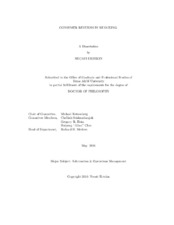| dc.description.abstract | In this dissertation, I develop econometric and optimization models to help retailers better manage their consumer returns. I shed light on some prevalent industry practices and beliefs relevant to consumer returns management and provide managerial implications while filling some of the existing gaps in the literature of consumer returns. In the first essay, I examine the association between in-store customer shopping experience during a purchase and subsequent return and repurchase behavior. Using over 21 million purchase and return transactions and nearly 75,000 customer satisfaction survey responses from a national jewelry retailer, I conduct a detailed analysis that incorporates a sample selection model with simultaneous recursive equation models. Return rates across stores within the same company can vary significantly. In the first part of this essay, I empirically examine this variation with respect to product quality, service quality, and customer satisfaction. The analysis reveals surprising findings for retailers. For instance, I demonstrate that retail efforts such as increasing salesperson competence and improving store environment, so long believed to reduce returns, may actually be associated with increased returns. I also show that service quality during a purchase can be more important than product quality in return prevention. In the second part of this essay, I provide empirical evidence that a return event can moderate the satisfaction-repurchase behavior link. More importantly, I show that that a return event may enable a retailer to regain a dissatisfied customer who would otherwise be lost.
In the second essay, motivated by common practice, I study the retail strategy of selling open-box returns side-by-side with new products. I develop a model to assess the impact of cannibalization due to open-box product sales on profitability and to identify the conditions in which selling them is preferred to simply salvaging them through liquidators. The operational decisions are the order quantity, the refund amount, and the open-box product price. The model captures important market characteristics that include consumer choice between new and open-box products, uncertainty and heterogeneity in consumer valuation for both products, and customer sensitivity to a retailer's return policy. I find that, even if open-box products cannibalize new demand, selling returns as open-box is always more profitable than simply salvaging them so long as there is demand for open-box products. Furthermore, retailers may increase their market share by selling open-box products if customer sensitivity to a retailer's return policy is low. If it is high, retailers should use a generous policy while charging premium prices. I also demonstrate that higher return rates do not necessarily lead to a decrease in profit. | en |


